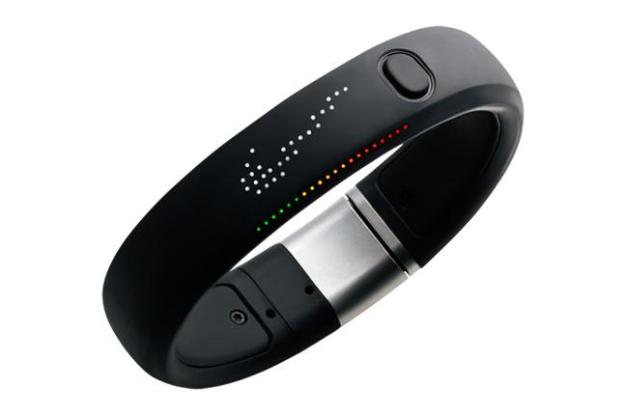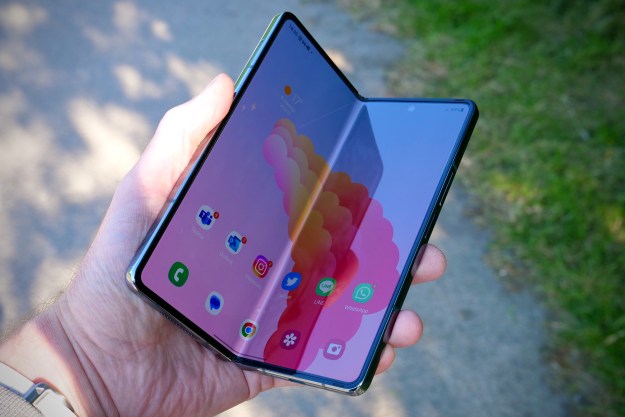
“Athletes and serious runners will easily be the most interested in this product, thanks to the host of products Nike is busy introducing to the Nike+ line up as well as their familiarity with the brand.”
- Great software
- Bracelet is comfortable and discreet
- Easy to set up, easy to use
- Integration with Nike+ community and Facebook
- Doesn’t track sleep; doesn’t track caloric intake
- Would make more sense if it were $20-$50 less expensive
The Nike+ Fuelband experience is a multi-“screen” experience in that you have the band’s LED display, the mobile app, and the desktop software. It’s the latest fitness tracker from Nike and the newest addition to its Nike+ community. With a simple design and ease-of-use, the Fuelband might be able to challenge less expensive products that do more – and let’s face it, that Nike logo isn’t hurting its chances.
Video overview
Look and feel
The Nike+ Fuelband looks and feels a lot like a heavier, sturdier Livestrong bracelet. It has a similar rubbery feel and isn’t much larger. Obviously, it’s less flexible and bulkier than this: it has a built-in USB, so it can’t be all that bendable.
Initially, the Fuelband drove me crazy. I don’t wear jewelry or a watch, so having anything constantly fastened around my wrist felt all kinds of wrong. Fortunately, this was short-lived and the only time I feel compelled to remove the Fuelband is occasionally in the middle of the night while I’m sleeping (safe to say I’m fairly inactive during this period of time, so nothing much is lost – the Fuelband isn’t a sleep tracker). The body can swell during sleep as well, so if your Fuelband is rather fitted you might take it off during the night as well.

Besides this, the Fuelband was perfectly comfortable and getting used to it was relatively quick and painless. It comes in three sizes, and there are spacers available if you find you need something in-between.
As far as looks go, it’s incredibly unassuming – for better or for worse. The Jawbone UP is arguably a more interesting aesthetic approach; it’s thinner and less utilitarian-looking. Of course, it sacrifices the LED display that the Fuelband has, which makes it much more useful. It’s easily the coolest part of the Fuelband and what makes this type of tech worth looking into; I don’t want to defer to an app to chart my activity. Having it there all lit up on your wrist — steps, calories burned, fuel level, time – makes it ridiculously accessible.
To summarize, is the Fuelband going to win any fashion contests? No. But it’s discreet and quickly highlights your activity.
What is fuel?
Given that your main objective is to meet your fuel goal, let’s take a minute to define exactly what that is. Here are a few snippets of Nike’s definition:
- NikeFuel is a proprietary technology that measures your activity through the movement of your wrist.
- The more you move, the more NikeFuel you earn.
- Nike worked with some of the world’s top experts in science and sports to engineer NikeFuel algorithms based on oxygen kinetics. Unlike calorie counts – which vary based on someone’s gender and body type – NikeFuel is a normalized score that awards all participants equal scoring for the same activity regardless of their physical makeup.
The band’s three-axis accelerometer measures motions and translates that into NikeFuel – as well as calories expelled.
Software
As you might have gathered, there isn’t much to say about the UI and navigation of the Fuelband bracelet itself. It has one button. You press it and the bracelet circulates through the available data. That’s it.
There’s more to the app and the desktop software.
App

The Nike+ Fuelband app works with the device as well as your Nike+ account to keep everything tracked on the go. It’s clean, polished, and a little limited. Editing much of your account info actually has to be done from the Nike+ Web client; on the app you can only change whether the app auto syncs and the unit measurements used (miles or kilometers). If you want to really dive into your stats and goals, the Web client and Nike+ Connect desktop software are the way to go.
But the app is a great complement to the bracelet. You get a deeper analysis of what you’re seeing on the LED screen in a quick format. You hold the button on the Fuelband to sync with the app, and then you can see how your current day’s progress is going, assess your weekly, monthly, or even annual stats, connect to Facebook for a social experience and challenges with your friends, and see your milestones. It’s a consumption-heavy app, there isn’t a lot you’ll want or need to do in it beside analyze your progress.
Web and desktop software
Your Nike+ account will be where your information can live on the desktop. Nike+ Connect is the downloadable software you’ll use with the Fuelband and the app. With the latter, you can plug your Fuelband into the computer to sync.

With your desktop Nike+ experience, you really start to see what the Fuelband is measuring. You see how many days in a row you’ve made or missed your goal, you can compare this to other Fuelband users’ performance, analyze your best days, add notes and emoticons to your individual days, and share any of the information you want (you can do much of this from the mobile app as well, it’s just much more intuitive to explore via desktop). You can also editing settings from here. In general, the desktop client just dives deeper into everything you get from the mobile app.

Performance and use
You’re welcome to buy the Nike+ Fuelband and go through all the setup steps yourself, but Nike was nice enough to assist me through the process. After fitting the band to your wrist, you’ll want your phone and a computer nearby (this is more significant if you haven’t already set up a Nike+ account). After creating your Nike+ account, you’ll download the app. From the computer or phone you can set your goal – there are three standard options with the median being a fuel level of 3,000.
You’ll need to connect the band and your phone via Bluetooth, but then you’re more or less ready to just start moving and letting it do its job.

The first thing I realized was that a 3,000 fuel goal was too easy. If you have a desk job in which you’re not entirely, but largely stationary and complement that with a daily workout of 1-2 hours, you will pass your fuel mark way too easily. I upped this to 4,500, which I’m usually able to meet but have had to push myself to get to on occasion.
Battery life hasn’t been a terrible issue; charging it for about 30 minutes every other day seems to do the trick. And while it’s not waterproof, the Fuelband has survived showers, heavy rain, and dog washing.

Initially, the band’s simple interface and details were enough to keep me interested. Then I wanted more information, so I turned to the app. After wanting yet more data, I started using the Web client.
All of these separate screens had exactly the effect they were supposed to: equal parts motivation and analysis. The feature I’ve ended up most interested in is the hourly breakdown of my activity. I can see at what times I moved most, when I meet my goal, and compare this with other days. This is part of the motivation as well: when you notice that during that week you oftentimes move so little during office hours, it’s impetus to get out of your chair for a few minutes.
Conclusion: Should you buy it?
If all you’re looking for is a pedometer with a Bluetooth, then keep on looking. You can get something way cheaper and simple for your money. But for anyone who enjoys exercising a moderate to high amount, this is a great supplement.
As are a host of other products – chief among them being the FitBit. It’s a little device that slips into your pocket, has proprietary software, and can do a few things the Fuelband can’t – namely, count calories you’ve consumed as well as track your sleep. And, here’s the kicker: it’s $50 cheaper. [Note: The Jawbone UP would be a competitor if a rerelease date existed.]
But there are a couple of key things a buyer will want to consider about the Fuelband. First, do you lose things or forget to grab something on your way to work? The FitBit doesn’t attach to you and if you’re forgetting it from time to time, it loses its purpose. More importantly, however, is that it doesn’t have a connection to the Nike+ family. In addition to the Fuelband, iPod Sport Kit, Sportband, Sportwatch GPS, and Sensor, Nike manufactures a series of running shoes that connect with Nike+ products to really push your integrated exercise to the limits. And if you like a community aspect, its Facebook integration and brand name pull mean that you’ll have the option of sharing updates and challenges with friends, something competitors can’t offer to nearly this extent.
Athletes and serious runners will easily be the most interested in this product, thanks to the host of products Nike is busy introducing to the Nike+ line up as well as their familiarity with the brand.
Highs
- Great software
- Bracelet is comfortable and discreet
- Easy to set up, easy to use
- Integration with Nike+ community and Facebook
Lows
- Doesn’t track sleep; app doesn’t have an option for tracking caloric intake
- Would make more sense if it were $20-$50 less expensive








